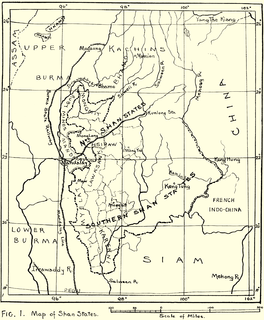| Loi ai | |||||
| State of the Shan States | |||||
| |||||
 | |||||
| History | |||||
| • | State founded | Before 1814 | |||
| • | Merged with Hsamönghkam | 1930 | |||
| Area | |||||
| • | 1901 | 517 km2(200 sq mi) | |||
| Population | |||||
| • | 1901 | 5,442 | |||
| Density | 10.5 /km2 (27.3 /sq mi) | ||||
Loi-ai (also known as Lwe-e) was a Shan state in the Myelat region of what is today Burma. It was one of the westernmost Shan states, bordering with Yamethin district of Upper Burma. The capital was Lonpo (Aungpan) and the population was mostly Pa-O, but there were also Danu, Shan and Karen people in the area. [1]

The Shan are a Tai ethnic group of Southeast Asia. The Shan live primarily in the Shan State of Burma (Myanmar), but also inhabit parts of Mandalay Region, Kachin State, and Kayin State, and in adjacent regions of China, Laos, Assam and Thailand. Though no reliable census has been taken in Burma since 1935, the Shan are estimated to number 4–6 million, with CIA Factbook giving an estimate of five million spread throughout Myanmar.

Myelat is a historical region of the southwestern Shan State of Myanmar. Originally this region included some of the smaller states typically ruled by "Myosas" or "Ngwegunhmus", buffering the plains of Burma and the ethnic Shan states further east.

The Pa'O are the seventh largest ethnic nationality in Burma, with a population of approximately 2,000,000 to 2,600,000.






